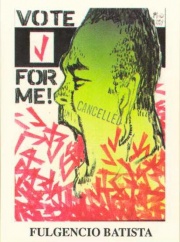Cuba Under Batista
From The Peopling of NYC
Cuba under Batista
Prior to the Revolution of 1959, under the regime of Batista, Cuba had very sharp class divisions. The largest of these classes was the peasant class, most of which could barely support themselves and their families. To contrast the poverty of the lower class was the handful of sugar mill owners, many of who were millionaires. However what had made Cuba different from other Latin American countries was that it always possessed a substantial middle class. The middle class consisted of doctors, lawyers, social workers and various other professionals. Though the culture allowed for some racial equality, a vast number of the poor were people of color, and the poorest of all were women of color.
Batista and Gambling
Those who remember Cuba during the regime of Batista remember a tourist paradise. Casinos were prolific, and operated by gangsters who were smart, or lucky enough to escape death and jail during the Capone years in Chicago. In Cuba they were welcomed as legitimate businessmen. Recognizing that a cleaner image attracts customers, they cleaned up their appearance, and enforced a strict no cheating policy in their casinos. Instead of the gun violence characteristic of the Capone years, in Cuba they simply paid of government officials so that they could operate without trouble. These “former” crooks were the best at their game. Few could afford to pay of government officials, handle the operating costs of lavish casinos, pay taxes and still turn a fantastic profit.
As soon as word hit the streets in the US that Cuba was a paradise tourists flocked by the thousands. Upon setting foot in Cuba, the tourist was dazzled by beautiful beaches on which they were allowed a choice of multimillion-dollar resorts. Of course there was also a choice of various vices, including gambling, which was prolific in casinos, hotels, and nightclubs, as well as a flourishing prostitution ring. Americans were able to feel at home in casinos, as most of those who handled the tables were American. Batista encouraged and had the government finance the casinos and various lotteries, as the government and Batista saw a large share of the profits. Batista’s brother in law controlled all 10,000 slot machines in Cuba, as well as all the parking meters. Add to these profits the income from the national lottery, which ran two drawings a day, and you have plenty from which corrupt officials could fill their pockets.

